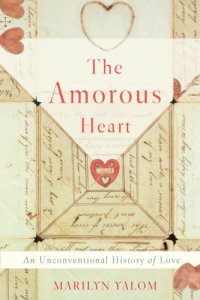
Ebook: The amorous heart: an unconventional history of love
Author: Yalom Marilyn
- Tags: ART--History--General, Heart--Symbolic aspects, Herz, HISTORY--Europe--General, Liebe, LITERARY CRITICISM--European--General, Love symbols, Romantik, Symbolik, Nonfiction, Heart -- Symbolic aspects, HISTORY -- Europe -- General, ART -- History -- General, LITERARY CRITICISM -- European -- General, Europa
- Year: 2018
- Publisher: Basic Books
- City: Europa
- Edition: First edition
- Language: English
- epub
The amorous heart in antiquity -- Arabic songs from the heart -- The heart icon's first ancestors -- French and German songs from the heart -- Romances of the heart -- Exchanging hearts with Jesus -- Caritas, or the Italianized heart -- Birth of an icon -- A separate burial for the heart -- The independent heart -- The return of Cupid -- The reformation and counter-reformation -- How Shakespeare probed the heart's secrets -- Heart and brain -- Exposing the female heart -- The heart in popular culture -- Hearts and hands -- Romanticism, or the reign of the heart -- Valentines -- I [love] U.;"The symmetrical, scalloped, exuberant heart is everywhere: it gives shape to candy and candy boxes, cookies and cakes, earrings and pendants, floral arrangements, jewelry containers, vases, soaps, padlocks, and frothy milk on top of a cup of coffee. We see it used as a verb on t-shirts ("I [heart] New York") and in text messages (the incredible variety of heart emojis). In all of its forms, and across borders, continents, and languages, the heart symbol conveys one thing, and one thing only: love. How can we explain the ubiquity and power of what might be the most recognizable symbol in the world? In The Amorous Heart, Marilyn Yalom embarks on an investigation into the heart's mysteries, tracking the heart metaphor and heart iconography across three thousand years and shedding light on how human beings have found, expressed, and experienced love itself"--;"An eminent scholar unearths the captivating history of the two-lobed heart symbol from scripture and tapestry to T-shirts and text messages, shedding light on how we have expressed love since antiquity The symmetrical, exuberant heart is everywhere: it gives shape to candy, pendants, the frothy milk on top of a cappuccino, and much else. How can we explain the ubiquity of what might be the most recognizable symbol in the world? In The Amorous Heart, Marilyn Yalom tracks the heart metaphor and heart iconography across two thousand years, through Christian theology, pagan love poetry, medieval painting, Shakespearean drama, Enlightenment science, and into the present. She argues that the symbol reveals a tension between love as romantic and sexual on the one hand, and as religious and spiritual on the other. Ultimately, the heart symbol is a guide to the astonishing variety of human affections, from the erotic to the chaste and from the unrequited to the conjugal"--
Download the book The amorous heart: an unconventional history of love for free or read online
Continue reading on any device:

Last viewed books
Related books
{related-news}
Comments (0)